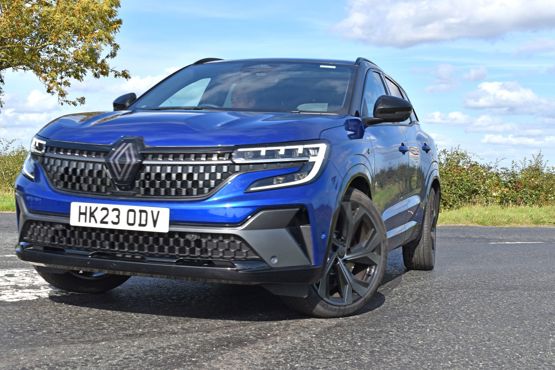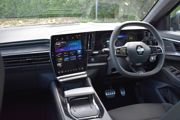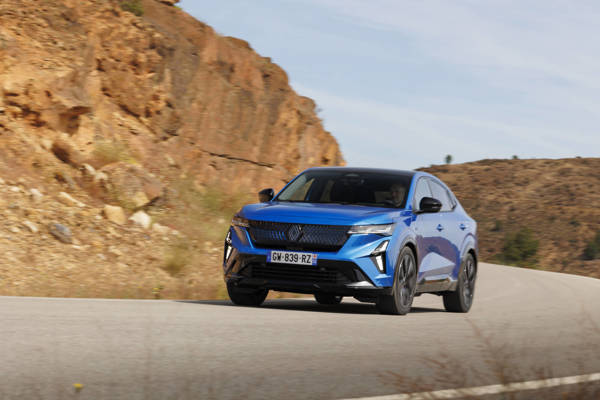Review
The choice of SUVs is so extensive and so varied it can be a burden trying to select what will be right for your company, meeting the requirements of its vehicles along with the needs and wishes of drivers.
Renault’s belief is it can achieve cut-through with a rebrand focused on the best tech available and quality in its price point.
In my estimation after six months with the Austral – which follows the Megane E-Tech in the brand’s journey to ‘Renaulution’ – has to a considerable degree achieved this, despite being pricier than its predecessor, the Kadjar.
Starting with the hands-on elements, the Austral’s technology and connectivity impressed with the multimedia system powered by Google.
Its Maps platform was so good, enhanced by the display on the 12-inch screen and nine-inch head-up display, it replaced my navigation faithful app Waze, thanks to its clarity which made journeys through the trickiest environments less stressful.
Throughout the cabin there was an air of touch-and-feel quality to the car. I’d go as far as saying that having driven a colleague’s Jaguar for a couple of weekends while running the Austral, there was no difference in quality between the two cars.
Driveability is another strong point. The Austral is poised and responsive, albeit with a firmer suspension setup than we're used to from Renault. It can be a little uncomfortable on rougher surfaces, but the less-forgiving ride does benefit handling.
Adding to the nimble nature of the Austral is its four wheel steering system. It benefits both low speed manouvering and higher speed cornering by turning the rear wheels in either the opposite or the same direction as the front ones.

Renault highlights the Austral's advanced engine technology, boasting ‘unmatched’ fuel efficiency and CO2 emissions.
However, my real-world testing discrepancies flagged early on in our running the car in achieving the advertised figures are unchanged. In 9,659 miles, 3,710 were in electric mode, my average fuel consumption was 47.3 mpg. Renault’s WLTP figure is 60.1mpg.
The difference in crude terms for unleaded petrol (based on an average UK per litre price of 142.78) for the total mileage is £1,044 versus £1,333, or £289.
Renault would defend its position by asserting that 80% of driving on urban roads is possible in full-electric mode, equating to a 40% reduction in fuel consumption than an ICE equivalent.
Full disclosure, living in the country, I drive day-to-day on anything but urban roads. This will affect the efficiency figures.
Renault emphasizes the rigorous testing process undertaken to ensure trouble-free driving, although some minor issues like rattling noises I reported and dealt with, plus the Bluetooth connectivity issues and seating/side mirror quirks were not big issues compared to the positives.
In conclusion, Renault's repositioning towards electrification and quality improvements is evident in the Austral, offering advanced technology, competitive running costs, and a focus on customer satisfaction, albeit with one or two minor annoyances.
Getting to grips with technology
The innovations embodied in the Austral – giving rise to more than 200 patents – include modifications designed to minimise CO2 emissions.
At the heart of these is the hybrid powertrain, which adjusts its configuration to the driving conditions.
These include full-electric, a combination of electric and petrol engine and regenerating (the wheels move the electric motor that charges the battery).
With the latter, information on how much energy is being generated is shown on the instrument panel when the brake pedal is pressed, or accelerator is released.
The multi-sense tech in the latest generation Austral means drivers can adapt the driving mode through a push button on the steering wheel.
They alter steering effort, engine responsiveness, interior lighting, temperature and instrument panel display and colour through three pre-programmed modes (eco, comfort and sport) and a fourth mode that lets the driver customise each setting. The most noticeable difference is in sport mode – the steering is tighter, the engine more responsive. I struggle to notice the difference in the other two.
In addition to what’s on-board, there are a number of connected services available under the ‘My Renault’ banner.
An app is available providing a number of handy services for drivers, for example being able to locate their car, for example in a car park or a festival field by flashing the headlights and honking the horn.
My Renault also offers some standard features such as display of real-time information on the car, such as its mileage, a spec list, a digital handbook and live chat, along with service contracts, maintenance log and dealer contacts.
A driver can find out when a car is due for a service, and the system predicts parts wear used to provide alerts on the condition of brakes, battery and tyres, and offer replacements.
For fleets there’s a connected service called Connect for fleet.
Multi-vehicle telematics data can be collated – mileage, mechanical alerts, driving behaviour, tracking fuel consumption and GPS-based vehicle locations – with the objective of reducing the administrative burden, minimising fleet costs, improve driver safety and support an environmental policy.

The quirks I’ve experienced so far have included issues getting the Bluetooth connection on my phone to work without my intervention each time I get in the car.
The audio system defaults to the radio and going through the on-screen menu to connect to my phone doesn’t always work instantly.
Solving it has entailed switching the console on and off again, or giving the systems involved (I’ll include my phone in this for fairness to Renault) a minute or two to ‘settle in’.
If anyone knows a way to make Bluetooth connection the default, please email me.
Another one to be aware of involves the auto positioning of the seating.
The Austral can ‘remember’ your favourite position and when you power on the car the seat moves to it. Make an alteration at any time and you’ll be asked via the centre console if you want this to be remembered. But the side mirrors don’t move with the seat position. Be sure to check this each time you drive to ensure, particularly the offside mirror, is in the best position as it moves to a default position when the car is locked.
How does it compare to rivals?
Renault says the Austral is its attempt to reconquest the C-segment.
While the brand promotes an upshift in quality and boasting a wide range of safety, comfort, and utilitarian technologies, which vehicle a fleet chooses in this very busy segment will come down to more prosaic factors, such as running costs and taxation.
So, lets have a look at these.
Our model, the E-Tech, FHEV iconic esprit Alpine (P11D value: £38,965) is here compared to the following:
- Hyundai Tucson 1.6 TGDi hybrid 230 N Line (£38,085)
- Ford Kuga 2.5 FHEV ST-Line X Edition (£39,570)
- Kia Sportage 1.6T GDi 212 HEV GT-Line S (£40,375).
And the following stats are based on a four years / 80,000 miles operating cycle.
The full hybrid system, with a 1.7kWh battery, leads the brand to promise 80% urban driving in full electric mode, equating a 40% reduction in fuel consumption compared to an ICE equivalent. Renault says the Austral is a 600-mile range electrified vehicle.
Renault’s claims about the Austral’s engine are backed up by the resulting figures, supplied by Cap HPI on fleetnews.co.uk.
They reveal a combined mpg figure for the Austral of 57.7, beating its competitors. The fuel per mile figure of 12.61 pence is below the rivals, with the Kuga coming closest at 14.15ppm.
With this comes the lowest depreciation figure of 29.28ppm, compared to the Sportage at 29.76, Tucson 30.33 and Kuga 34.69.
Considering service, repair and maintenance costs the Austral’s figure of 4.67ppm falls behind the Kuga at 4.02 and Sportage (4.6ppm) but is ahead of the Tucson’s 5ppm.
Despite this the Austral has the lowest total cost per mile figure at 46.55p, followed by the Sportage (49.29), Tucson (50.27) and Kuga (52.86).
Finally, CO2 emissions and benefit-in-kind tax.
With the lowest emission figure of 110g/km, the Austral attracts 27% in tax, the lowest of the competitors. A 20% taxpayer will have a BIK bill of £2,104 (2023/24), compared to the Tucson at £2,503, Kuga £2,374 and Sportage £2,503.

In an update on the rattle emanating from the rear seating area of the Austral mentioned in my previous review, I think I’ve found a way to stop it.
The Harman Kardon sound system, available as an optional extra, comes with 12 speakers, including two woofers in the front and rear door panels, and a sub-woofer in the boot. Adjusting the volume of the woofers has brought an end to the annoying noise in particularly bassy tracks on the stereo.
A step-up in quality
The point at which man and machine collide is in the driving seat with any car and it’s critical to the judgement of a car that it’s as satisfying, or at least benign as possible.
A centre point of this experience is the 12-inch screen and a nine-inch head-up display. A selection of Google services are available, including Play, Maps and Assistant, complemented by up to 35 additional apps, offering support route planning finding parking spaces and controlling home devices.
The generously sized centre screen is one of the most positive aspects of the driving experience. Renault claims it's one of the biggest fitted to a vehicle and its proportions and clarity has made route navigation one of the most useful and user friendly of the Austral’s tools.
If you know Google Maps, you’ll be familiar how it can be essential to route planning, particularly on-the-go in finding the least congested route.
Further enhancing its useability is the function to have a simplified version of the mapping display in the instrument panel above the steering wheel.
It’s easier and safer to glance at it too. This plus the large high-definition screen combined is one reason you don’t have to use your mobile phone, traditionally held in a cradle wedged in an air vent, so the temptation to fiddle with it is removed too.
There’s also a wireless phone charging point on top of the centre storage box. It even works ‘through’ a phone’s protective case. When the phone is connected via Bluetooth, the charge level is shown on the multimedia screen.

In its aspiration for the brand to become an industry benchmark for technology and connected services, Renault has, in the Austral, gone a long way in my estimation to achieving it.
Renault describes the testing process in ensuring the Austral is trouble-free for drivers and fleet managers as rigorous at every stage of production. Now I don’t know the numbers for other manufacturers, but those for this SUV sound impressive.
Nearly 1,000 points of the car were assessed through the design phase by staff (and a panel of consumers); the Austral E-Tech hybrid was driven nearly two million miles (75 times around the world) on all round types in pre-launch testing. It included a UK-based stage. This regime led to 350 improvements.
Now, I just wish one of the boffins/consumers had spotted that certain low bass frequencies set off a rattling somewhere at the back of the car over my left shoulder. Annoying with the optional Harman Kardon, 485-watt audio system.
I’ve investigated by sitting in the back seat and the problem seems to be buried deep in an interior panel around one of the 12 speakers. I’m not going to start routing around to fix it. If it gets to Guantanamo Bay levels of annoyance, I’ll get it looked at.
Want to see an example of the focus put on quality in the Austral? The sliding hand rest:
Understanding the hybrid system
Renault places significant emphasis on the engine technology of the Austral and the resulting performance figures for its brand new E-Tech full hybrid engine.
With combined petrol/electric power of 200PS, Renault claims it delivers the best consumption to performance statistics on the market.
Standout amongst those are the ‘unmatched’ levels of fuel efficiency and CO2 emissions – up to 60.1mpg combined WLTP cycle, and 105g/km CO2 respectively.
A genuine alternative to diesel, says the brand, and one of the ‘most cost-effective hybrid SUVs to run’.
The development of the engine led to more than 200 patents, Renault says.
New features include the 2kWh 400v battery and a cooling device meaning it can maintain performance in all operating conditions, and importantly increases the amount of time you can drive in electric mode, helping boost those efficiency and emission stats.

The technology combines a 1.2-litre turbo petrol engine, two electric motors (one for electric driving and charging the battery, the other to start the combustion engine, shift speeds and help to charge the battery), providing two speeds in electric and four for the petrol engine.
Plus, the energy regeneration resulting from deceleration and braking is designed to enable 80% of your time on city roads in full-electric mode which, Renault claims, equates to 40% fuel savings compared to a petrol engine, with no required change in driving style.
Lofty claims, but are they borne out by my experience?
I’m achieving nowhere near the 60.1mpg figure after a month of driving the car. Across a variety of road conditions from winding, slow - read extremely muddy - country lanes (it was first pumpkin season, now potato in the rural area I live in) to A-roads and motorways on longer journeys I’ve achieved an average of 48.1mpg, a difference of 12mpg. Taking a recent roundtrip from home to Birmingham NEC for Fleet & Mobility Live of 150 miles.
Using Fleet News’ fuel costs calculator the cost of unleaded petrol at 155.89 pence per litre at 60.1mpg would be £35.43. On my performance it costs nearly £10 more. Over an 80,000-mile operating cycle, the difference in costs is more than £2,000.
Now, I know there’s a widespread acknowledgement of the differences in manufacturer figures and drivers’, but the public (and often professional), uncertainty around the benefits of hybrid over petrol, and in this case diesel you could ask why all the focus on technological advancements if I’m not experiencing all the benefits?
I’m banking on, firstly improving my driving performance, and finding many more factors to support the claims made by Renault for this important model in its range.
Renault Austral E-Tech Esprit Alpine joins our fleet
“If you think you know Renault, think again.” This is how Renault’s head of fleet and used vehicles Peter Horton emoted the transformation of the company from volume to profit focused for the business, and an electrified, upmarket brand for the customer.
Renault’s marketing the car around the word ‘Renaulution’, mixing cutting-edge technology and improved quality, and being used to entice fleets to take a fresh look at what it has to offer.
The Megane E-Tech range was the first iteration of this ethos to come to market. Then came the Austral, with orders from May and deliveries from July.
It replaces the Kadjar and is the focus of Renault’s efforts to ‘re-conquer’ the C segment. Reflecting the upmarket move, the cheapest Austral costs more than its most expensive predecessor.
And instantly separating it from the Megane E-Tech is the fact there is no 100% electric model available.
The Austral (meaning the southern hemisphere; think Australia) instead debuts a more efficient version of the E-Tech full hybrid engine. Every model in the range is powered by the new 200PS petrol hybrid engine.

Exploiting this is an electric-only mode for zero emission city driving with the battery recharging in the familiar way, when the car is decelerating and braking, with no facility to plug the SUV in.
Renault stresses the point that 80% of driving on urban roads is possible in full-electric mode, equating to a 40% reduction in fuel consumption than an ICE equivalent. As such it says the Austral is a 600-mile range EV.
Key stats are the 60.1 mpg combined cycle efficiency and 105g/km CO2 emissions. Benefit-in-kind is at 27%, one year VED £175 and the insurance rating 23E.
As such Renault claims the Austral is one of the most cost-effective hybrid SUVs and a “genuine alternative to diesel”.
The Austral is available in three trims Techno, Techno Esprit Alpine and Iconic esprit Alpine. It’s the first Renault model to have the Esprit Alpine branding.
A cornerstone of the onboard tech is the OpenR Link multimedia system incorporating Google.
OpenR Link is designed to make the car as intuitive as a smartphone, with the Austral acting as the hardware equipped with ‘state-of-the-art software and optimised connectivity’, based on the Android operating system.
So, it’s naturally compatible with Android Auto and Apple CarPlay, as plug-in or wireless, and offers navigation with Google Maps, hands-free help with Google Assistant and Google Play apps, complemented by features on the My Renault app.
The model I’m driving is a top of the range Iconic Espirit Alpine. Its recommended on the road price is £39,495, but with the metallic paint option, the price is £40,945.
Taken all the above into account, there’s a lot to judge in the next six months.
Jeremy has been a journalist for 30 years, 20 of which have been in business-to-business automotive. He was a writer and news editor on Fleet News for three years. He is Bauer B2B’s head of digital operations helping to manage the digital assets of Fleet News and Commercial Fleet, together with sister-brands AM and Rail. For six years he was AM's editor.





















 Petrol Hybrid
Petrol Hybrid

















